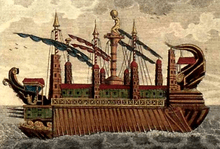Syracusia

Syracusia (Greek: Συρακουσία, syrakousía, literally "of Syracuse") was a 110 m (360 ft) ancient Greek ship sometimes claimed to be the largest transport ship of antiquity.[1] She only sailed once, from Syracuse in Sicily to Alexandria in the Ptolemaic Kingdom.
General characteristics
Syracusia was designed by Archimedes and built around 240 BC by Archias of Corinth on the orders of Hieron II of Syracuse. The historian Moschion of Phaselis said that Syracusia could carry a cargo of some 1,600 to 1,800 tons and a capacity of 1942 passengers.[2] She reputedly bore more than 200 soldiers, as well as a catapult. She sailed only once to berth in Alexandria, where she was later given to Ptolemy (Ptolemaios) III Euergetes of Egypt and renamed Alexandria (Greek: Αλεξάνδρεια, literally "of Alexandria").[3][4]
A discussion of this ship, as well as the complete text of Athenaeus (a late 2nd-century Greek writer who quotes a detailed description of Syracusia from Moschion, an earlier, now lost, writer) is in Casson's Ships and Seamanship in the Ancient World.[2]
Of particular interest in the discussion of the construction of the ship is the detailed description of the efforts taken to protect the hull from biofouling, including coating it with horsehair and pitch.[4] This may be the first example of proactive antifouling technology (designed to prevent the attachment of fouling organisms, rather than to remove them).
Appearance
Not much is known about the outside appearance of the ship, but Athenaeus describes that the top deck, which was wider than the rest of the ship, was supported by beautifully crafted wooden Atlases instead of simply wooden columns.[4] Additionally, the top deck featured eight towers, equipped with two archers and four fully armed men.[4] On the bow of the ship was a raised platform for fighting, on top of which was a giant catapult.[4] 20 rows of oars would also have been visible from the outside, and possibly a promenade lined with flowers and tents for use by the passengers.[4]
Amenities
In terms of passenger comfort, Syracusia would be the equivalent of Titanic compared to other ships of the era.[5] Her innovative design and sheer size allowed for the creation of various recreational spaces aboard, including a garden and an indoor bath room with hot water.[4] The lower levels of the ship were reserved for the crew and the soldiers on board, while the upper levels were for the use of passengers.[1][4] According to Athenaeus, the ship was beautifully decorated using materials such as ivory and marble, while all public spaces were floored with mosaics depicting the entire story of the Iliad.[1][4][6] The ship was also equipped with a library, a drawing room and a gymnasium for use by the passengers, as well as a small temple dedicated to Aphrodite.[1][4]
Legacy
Ptolemy's son sought to outdo Syracusia. He ordered the construction of a huge warship, the Tessarakonteres: 420 feet long, and bearing more than 4,000 oarsmen and 2,850 soldiers.[7] However, according to Plutarch, it was almost immobile.[8]
See also
- List of world's largest passenger ships
- List of world's largest wooden ships
- Nemi ships
- Caligula's Giant Ship
- Tessarakonteres
References
- 1 2 3 4 Hirshfeld, Alan (2009). Eureka man: the life and legacy of Archimedes. Walker Publishing Company Inc. Retrieved 22 May 2011.
- 1 2 Casson, Lionel (1971). Ships and Steamanship in the Ancient World. JHU Press. Retrieved 22 May 2011.
- ↑ Humphrey, John W.; Oleson, John P; Sherwood, Andrew N. (1998). Greek and Roman technology: a sourcebook: annotated translations of Greek and Latin texts and documents. TJ International. Retrieved 22 May 2011.
- 1 2 3 4 5 6 7 8 9 10 Athenaeus of Naucratis. "Deipnosophistae". Book 5, Chapter 40. Retrieved 22 May 2011.
- ↑ Superships (2007). Ancient Discoveries. The History Channel. Season 3, episode 4.
- ↑ Burn, Lucilla (2004). Hellenistic art: from Alexander the Great to Augustus. The British Museum Press. Retrieved 22 May 2011.
- ↑ Lionel Casson (1995). "Chapter 6". Ships and Seamanship in the Ancient World. Johns Hopkins University Press. pp. 108–109. ISBN 0801851300.
- ↑ Lionel Casson (1995). "Chapter 6". Ships and Seamanship in the Ancient World. Johns Hopkins University Press. p. 140. ISBN 0801851300.
Further reading
- Fik Meijer, André Wegener Sleeswyk: "On the Construction of the 'Syracusia' (Athenaeus V. 207 A-B)", The Classical Quarterly, New Series, Vol. 46, No. 2 (1996), pp. 575–578
- Jean MacIntosh Turfa, Alwin Steinmayer Jr: "The Syracusia as a Giant Cargo Vessel", The International Journal of Nautical Archaeology, Vol. 28, No. 2 (1999), pp. 105–125